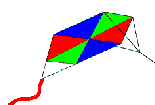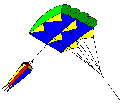The Kite Society is not responsible for the content of external Internet sites.
Copyright © The Kite Society of Great Britain 2000 -



Flying a kite is easy, but there are a few simple tips that make flying the kite even easier and, more to the point, safer for you and others around you.
- Always read the instructions first. These would normally give the proper assembly
information as well as basic flying hints and tips. A guideline to the strength of
the wind suitable for the kite may also be printed -
do not exceed this as the kite can become uncontrollable. See below for a simple wind speed guide. - Never fly kites in wet or stormy weather. Static electricity can build up and be conducted down the line. This is also the reason why you should never fly a kite with wire or anything metallic in the line.
- Never fly kites over other peoples heads or in an area where someone else could be injured from an out of control kite. If you are new to kite flying make sure there is plenty of room around you.
- Do not fly close to roads or paths. Not only can it be dangerous if the kite comes down but it can distract drivers as well.
- Keep away from overhead power lines, transmission towers, telephone lines and aerials.
If your kite gets caught -
DO NOT attempt to rescue it yourself - ask for help from the right people such as the electricity company. - Always be aware of what is behind you, be it people, roads or even cliffs! It is easy to be distracted by the kite and step back.
- Always wear gloves for strong pulling kites.
- Do not fly near airports or above 200 feet (60 metres) -
see the Rules of the Air. - Always tidy up after you. Take away any odd bits of line you have discarded, the bag that the kite came in, etc. Throw them away responsibly or recycle them.
- Be careful of animals, they can be easily frightened by flying kites -
particularly dual and four line kites. - If you are new to kite flying then consider contacting one of the many local groups
for advice-
see the group directory. If you have purchased a dual line sports or power kite, consider taking lessons in how to fly the kite, the kite trader you bought the kite from should be able to guide you in the right direction. Training is particularly important for power kites as these can be very dangerous if not flown properly. - When flying in the vicinity of horses please be aware of the issues by reading this article.
- Finally, be courteous and think of others. Not everyone is happy with kites buzzing
around them. If someone else thinks your kite is a danger to others and asks you
to stop -
do so. They may be more aware of what is happening than you are.
Fly Safe -
Wind Speed
There is a general scale of wind speed known as the Beaufort Scale. This gives a simple indication of the wind speed which can be matched to the recommended wind speed for the kite you are flying.
|
Force
|
MPH
|
|
|
0 |
0- |
Calm. Smoke rises vertically |
|
1 |
1- |
Light Air. Direction of wind shown by smoke drift but not wind vane |
|
2 |
4- |
Light Breeze. Wind felt on face; leaves rustle; ordinary wind vanes move. |
|
3 |
8- |
Gentle Breeze. Leaves and small twigs on constant motion. Wind extends light flag. |
|
4 |
13- |
Moderate Breeze. Raises dust and loose paper; small branches are moved |
|
5 |
19- |
Fresh Breeze. Small trees in leaf begin to sway; crested wavelets form on inland waters |
|
6 |
25- |
Strong Breeze. Large branches in motion; whistling heard in telegraph wires; umbrellas used with difficulty. |
|
7+ |
32+ |
Generally dangerous to fly kites! |
|
|
|
|
|
|
Delta Kite. Ideal for lighter breezes force 1 to 3. |
Hexagon Kite. Best suited for force 3 to 5. |
Box Kite. Fles best in force 4 to 6. |
Parafoil: Flies in force 4 to 6. |



